2013 Kawasaki Jet Ski Ultra 300LX Review
Awesome power with added luxury and refinement
What makes Kawasaki’s Jet Ski Ultra 300LX different than the Ultra 300X? To be perfectly frank, not that much. And in many ways, that’s a good thing.
There are differences, of course. That LX designation is indicative of the craft’s luxury and touring focus. The most obvious example is found in the tiered seat, which, unlike the 300’s almost continuous profile, features two distinct levels and shaped bolsters to provide greater back support. The styling is far more comfortable for passengers cruising long distance, but also more enjoyable for just the average casual ride. Passengers sit slightly above the person in front, giving them a clearer view forward rather than burying them in line, while the driver gets wraparound support that should ease back strain over time.
Another nod to touring is found in the handlebar pad. A pop-out plug reveals a nook sized to fit a handheld GPS. Serious touring types can pop one in and have their course information front and center.
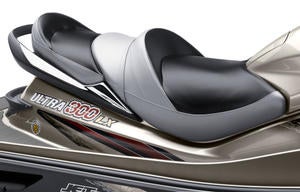 A tiered touring seat offers more back support for the driver and a better view for the passenger.
A tiered touring seat offers more back support for the driver and a better view for the passenger.And then there’s the color. Rather than the Ultra 300X’s more in-your-face primary colors, the LX features a rich metallic titanium with just a hint of red in the graphics. Think yacht club more than racetrack.
Beyond these nods to the good life, however, the Ultra 300LX is still very much the Ultra 300X. And that means performance remains a big part of the craft’s appeal. There’s an industry-topping 300 horsepower residing under that seat, developed by a 1,498cc four-cylinder engine boosted by an Eaton Twin Vortices supercharger and intercooler. The latter combo is the result of a switch Kawasaki made several years ago. The new supercharger style’s biggest advantage is that it creates steady power throughout the powerband. Rather than come on in waves, the power is immediately felt as soon as the throttle is squeezed, and never lets up. Though 65 mph (with a 2 mph leeway) is what you can expect in average conditions with a good passenger load and full tank of fuel, I recently posted a 69 mph solo run with my relatively light (150 pound) weight and a low fuel tank.
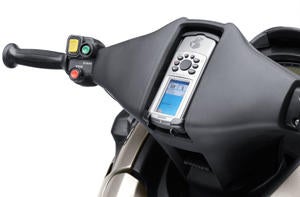 With long-distance tourers in mind, Kawasaki made room for a handheld GPS in the handlebar pad.
With long-distance tourers in mind, Kawasaki made room for a handheld GPS in the handlebar pad.That power comes on strong, never falters midway, and just rockets the craft across the water on the top end. It is, in a word, awesome.
And made even more so by the hull below. By now it’s no secret that offshore racers have flocked to the Ultra platform. With a deep, 22.5-degree deadrise, its hull tracks exceptionally well in rough water, almost never getting sidetracked from its course or causing the driver a moment of anxiety. It’s simply a beast, built to inspire the utmost confidence for those at the controls. While that rough-water superiority used to define the craft, it has now also been complemented by a sharp-handling manner in calmer conditions. Rather than the sweeping turns of old, the Ultra now hooks up aggressively. The difference is the result of several changes. First and foremost is the addition of electric trim, which now lets riders pivot the jet nozzle downward and thus drop the bow for greater contact with the water, or raise it for speed, within an eight-degree arc. A shortened steering nozzle has also quickened the boat’s reflexes, while a top-loading scoop grate ensures the pump stays hooked up in changing conditions. The boat’s cornering style is also highly intuitive. Lean in, as you would expect, for greatest control. The end result is a boat that still dominates rough water, but has a newfound fun factor when cornering in smoother conditions.
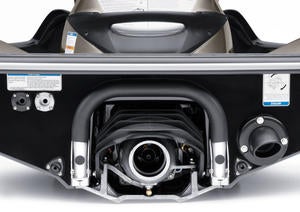
Features? Cruise control and no-wake mode tie in nicely with the touring angle, although both features are offered on the Ultra 300X as well. Cruise control is great for those extended rides, allowing the driver to set a speed and then maintain it by simply squeezing the throttle. The resulting full grip on the handlebars is far less tiring on an extended ride. Cruise is also appreciated by a wakeboarder or skier, as it allows the driver to maintain a steady speed.
No-wake mode requires no pressure on the throttle at all, and will keep a roughly 5 mph average speed through those extended slow-speed zones. A third speed control mode, dubbed “fuel economy assistance” mode, is designed to do just what it implies – govern speed to save fuel. One unique difference I’ve found between the brands is that Kawasaki’s eco-minded mode maintains a much peppier response from the engine.
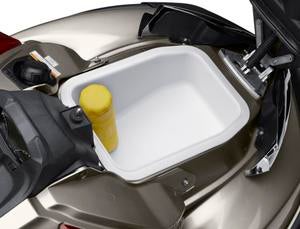 With 56 gallons of storage space available, the Ultra 300LX has room for just about everything.
With 56 gallons of storage space available, the Ultra 300LX has room for just about everything.
The Ultra’s storage and fuel capacities also fit well with touring, but again, are par for the course. Storage is an impressive 56 gallons, with a huge bow locker providing most of that real estate. A glove box keeps smaller items closer at hand. Fuel capacity, at 20.6 gallons, is also an industry-best. Still, play a little too much with that amazing engine and you may find you still empty it faster than you might expect.
And then there’s the Ultra’s five-position tilt steering. For extended rides, differing size riders, or just those who prefer to stand to absorb the shock of waves, it’s quite welcome.
In summary, no, the Ultra 300 LX is not that different from the Ultra 300. But to that performance customer who wants just a touch of luxury or touring refinement, it’s exactly what it’s meant to be – one powerful, luxurious machine.
| 2013 Kawasaki Jet Ski Ultra 300LX Specs | |
| Length | 132.7 inches |
| Beam | 47.0 inches |
| Curb Weight | 1,018.7 lbs |
| Engine | Four-cylinder DOHC EFI; Supercharged/Intercooled |
| Displacement | 1,498 cc |
| Bore and Stroke | 83mm x 69.2mm |
| Compression Ratio | 8.4:1 |
| Rated Horsepower | 300 |
| Fuel Capacity | 20.6 gal. |
| Combined Stowage Capacity | 56 gal. |
| Colors | Metallic Titanium |
| Price | $15,499 |
Related Reading
2013 Kawasaki Jet Ski Ultra 300X Review
2013 Kawasaki Jet Ski Ultra LX Review
2013 Yamaha FX Cruiser SHO Review
2012 Sea-Doo GTX Limited iS 260 Review
Get PersonalWatercraft.com in your Inbox!
Like PersonalWatercraft.com on Facebook
Comments
Most Popular

Remembering the Sea-Doo XP

2025 Yamaha JetBlaster PRO 2-Up Review

2024 Yamaha GP HO Review

2008 Kawasaki Jet Ski Ultra 250X Review

2024 Kawasaki Jet Ski STX 160X Review
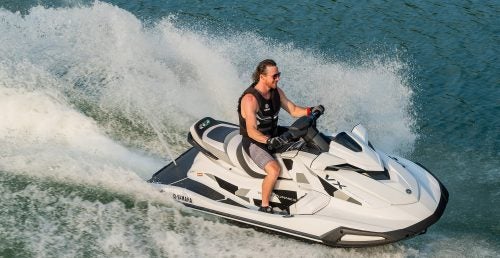



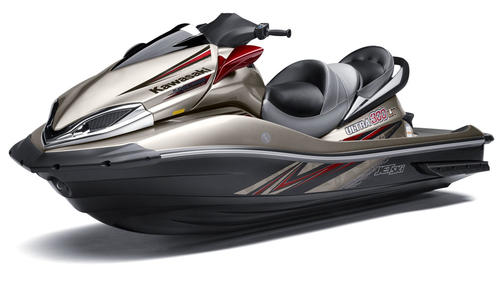
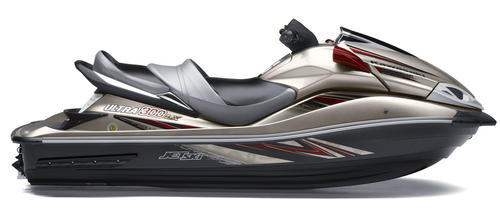







 Your Privacy Choices
Your Privacy Choices